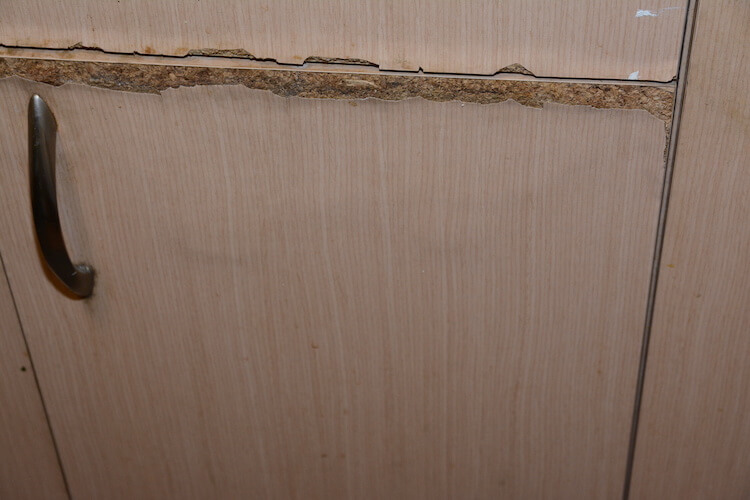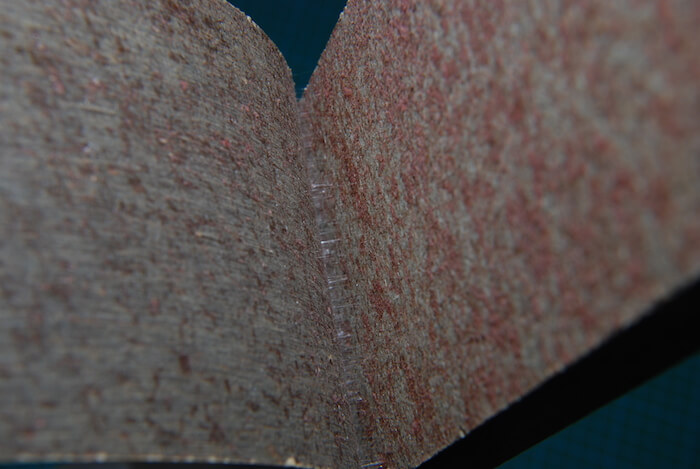Whether it is kitchens or bathrooms, we have all experienced or heard of damages to cabinets linked to humidity. As an example, let’s just consider cabinet panels that swell or coating shell (veneer or thermoplastic) that delaminates. This type of degradation usually occurs as a result of long term usage, when the cabinetry components “get old”. However, there are many cases where this type of millwork suffers from premature degradation. For instance, when similar damages are visible over multiple units of a building/condominium, it seems obvious that they are not independent and isolated cases.
More often, deficiencies and defects in manufacturing or improper installation practices are the likely root cause. To get a better idea of the causes that lead to these failures, it is very important to understand the composition of these wood cabinets. Usually the panel (door or interior walls) is made up of a core comprising a mixture of wood particles/fibers bound together by a resin. The core is then covered – on all/ most faces and edges – with a laminate (e.g. veneer), which is less than 3 mm thick and is also saturated with resin. The most common core materials used are:
- Particleboard
- Medium Density Fiberboard – MDF
- Hardboard – HD
The panels are also classified as per the method used to adhere the laminate/veneer onto the two largest faces of the panel:
- Thermal binding of the laminate to the core material.
- Use of a special adhesive to bind the laminate to the panel.
Consequently, different types of failure modes will be witnessed depending on the assembly. Amongst the most common cases are those related to the excessive absorption of humidity, which causes the panel to swell or even chip/break (figure 1). In the gluing method, the use of an inappropriate adhesive (or the wrong application thereof) can result in delamination of the finish (veneer).

THE TERM “MELAMINE” AS A MISNOMER
Scientifically, melamine is a molecule. In everyday use, melamine-formaldehyde resins are commonly referred to as melamine, for convenience. Together with formaldehyde, it is used as a building block for melamine-formaldehyde (MF) binder systems/resins.
To add to the ambiguity, the laminate or the composite panel itself is also coined as melamine in the construction industry and by end users in general. In fact, the term is used as a misnomer simply because melamine resins are extensively used as binders. In that respect, it should be pointed out that there are actually, on the market, three main types of binders for the core material and the laminate:
- Melamine resins (MF)
- Phenol formaldehyde resins (PF)
- Urea formaldehyde resins (UF)
Of the three, UF resins are of the lowest quality and are for economic reasons the most commonly used binder system. In fact, for a typical low-cost laminated panel, UF will be used as binder for the core material while the veneer will contain MF resins. This configuration is chosen to lower production costs, since the core of the panel (greater volume) requires a larger amount of resin than the thin covering shell (veneer).
THE NEED FOR A “GOOD” RESIN
Wood cabinetry made with UF resins are more sensitive to humidity and heat variations compared to those bound with MF or PF resins. The UF containing panels are said to have less dimensional stability, meaning that they are more prone to swelling given the cohesive/ adhesive forces are weaker than those of their MF or PF based counterparts.
One other crucial factor impacting the integrity of the panel is the type of wood used. Classical particleboards usually consist of sawdust or a mixture of wood chips and hence, the adhesion between the binder and the different wood species present in the mixture varies undeniably. In order to ensure an optimal binding, manufacturing parameters (e.g. curing time and pressure) must be controlled. If not, the panels may fail right during the early stages of their service life.
However, such wood panels and binders have a long history in the construction industry and thus, there are various standards defining the requirements of their expected performance. These standards provide guidelines and tolerances, especially in terms of humidity and good installation practices. In Canada, the CAN/CSA O437-93 series is a popular standard which, for instance, determines the resistance of the binder to water and boiling water. Another well-known document would be the CAN3-O188.1-M78 standard, which has long been used for particleboard.
GLUING THE COVERING SHELL TO THE CORE MATERIAL
As mentioned earlier, a second method to bind the laminate to the core panel is to use an appropriate adhesive. This task is completed either at the factory shop or on site by the installer. In particular, contact adhesives are an interesting choice for this application since they provide auto adhesion and hence, no need to use clamps or other fixture devices to hold the mated parts together during curing.
Such contact adhesives are generally made with polychloroprene (neoprene) and are applied on both the laminate and the core panel through spray or roll coating. The curing process then takes place (usually at room temperature) until the adhesive becomes nontacky. Finally, the laminate is pressed against the core (slight-to-moderate pressure) and the polychloroprene crystallizes, thereby forming a permanent bond between the two components. One of the drawbacks associated with contact adhesives is that they require additives to improve their resistance to heat and aging. Without adequate additives (or dosage), the contact adhesives are vulnerable to dechlorination reactions and oxidation which, in both cases, lead to the adhesive to become non-functional. Very often, the adhesive will change color and become brittle (figure 2).

Nowadays, there are specific chemical methods to follow the extent of this degradation. The different analysis tools available also allow us to determine the composition of an adhesive, and to detect signs of incompatibility between the adhesive and the binder, in some cases. Unfortunately, most labs simply stop at the detection stage of the investigation, without an interpretation of the results towards finding the cause of the failure.
As for the wood panels, there are applicable standards for contact adhesives as well. One of the most popular standards is the CAN/CGSB-71.20 of the Standards Council of Canada.
CONCLUSION
Because of their very function and their localization in the house, kitchen and bathroom cabinets are exposed to humidity and heat variations. Albeit their long-established use in the construction industry, manufacturing flaws or installation shortcomings are possible and can lead to early failures of the cabinetry. In severe cases, it may even cause mold/fungi proliferation.
Based on experience, we have developed at CEP an expertise for this type of failure investigation. For instance, this would include experimental setups to test moisture resistance of panels. In addition, in-house chemical analysis is readily available. These comprise interpretations of the chemical results as well as establishing the link with the root cause of a loss.
If you have any questions or would like to learn more about this topic, please contact our Materials Engineering team at 877 686-0240 or info@cep-experts.ca
